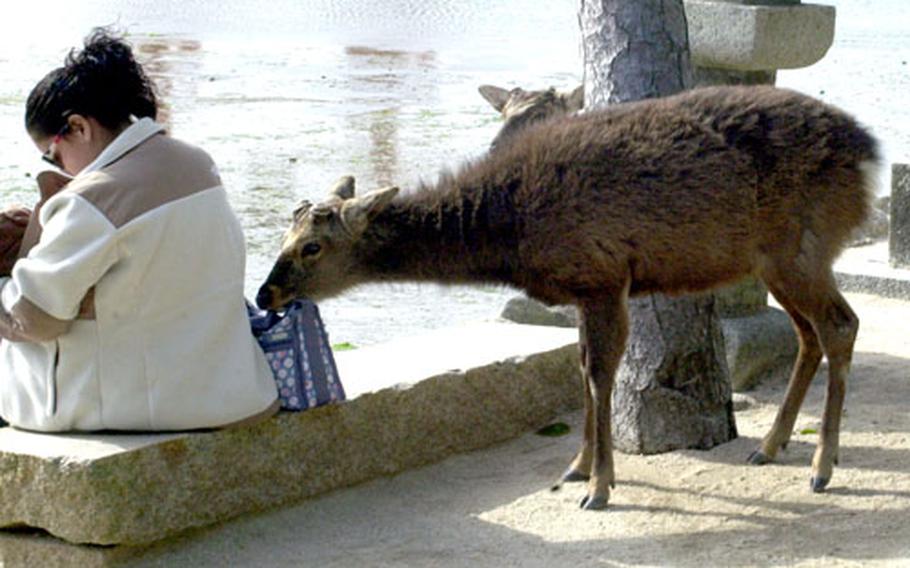
While the author's wife protects their baby boy, one of Miyajima's intrusive deer sniffs at her purse in search of delicious Japanese peanut crackers. (Paul Newell / S&S)
In less than three months, my tribe is outta here. Sayonara, wonderful Japan!
To squeeze the most from our remaining time, we planned a 10-day trip in March that would start in Tokyo and take us to Kobe, Hiroshima, Beppu, Sasebo and finally Hakone.
That plan never materialized.
Once we got to Marine Corps Air Station Iwakuni and discovered how much there was to do around the picturesque base, we canceled the Kyushu leg of the trip and made MCAS Iwakuni headquarters for a fantastic and very affordable five-day adventure.
We stayed on base at the Kintai Lodge. Kintai rooms are affordable, equipped with kitchenettes and have enough area for the little ones to crawl around. As vacationers whose visit coincided with a swell of servicemembers staying there on orders, we spent almost every night in a different room. With a load of baby stuff, this was a little inconvenient, but well worth it considering we never spent more than $35 a night.
On our first full day in Iwakuni, we took a 45-minute train ride to Hiroshima. As with most tourists visiting this significant city, we were there to see the A-Bomb Dome, Peace Park and tour the museum commemorating the history surrounding mankind’s first deployment of a nuclear weapon against its own. The museum was grim but necessary. We would honestly never choose to visit Hiroshima again, but going at least once is mandatory for those living here, especially those serving in the military. If you go, find a restaurant that prepares okonomiyaki, the savory pancake loaded with seafood, veggies and cheese and topped with a unique sauce.
Kintai Bridge and the surrounding town was our stop the next day. Just 15 minutes from MCAS Iwakuni, we were happily surprised that there was far more to this attraction than just visiting the famous rolling overpass reconstructed in 1953 after a flood destroyed the 1673 original in 1950. On the other side of the bridge is a scenic town. Tasty soft-serve ice cream and other goodies were everywhere. For kids, there are often monkey shows and a gondola ride up the mountainside that provides a wonderful view of the bridge and leads to Iwakuni Castle. As we walked back across the bridge and headed back to the car, we grabbed a few sticks of yummy chicken yakiniku for the road, very pleased with our day trip to Kintai Bridge and its surrounding area. Our only regret was narrowly missing the striking cherry blossoms that surround the Nishiki River.
Miyajima, a beautiful isle that’s about an hour drive from Iwakuni and a 10-minute ferry ride across the water, is where we spent our last two days.
The isle’s dark orange shrine and buildings offer a vivid contrast against lush hillsides and blue waters. The air is scented sweetly by the tasty bean-filled momiji manju maple cakes. And those who can afford it may choose to stay at one of the exquisite ryokans, the traditional Japanese inn that reveals the thoughtful intimacy of this nation’s people.
If there is just one word of caution, it’s this: Beware of the deer. It’s not that they are really vicious (locals have sawed down their antlers to leave them defenseless), but if they detect food, they’ll pester tourists to the point where they have two choices. Choice A: give them the vittles and hope it satisfies them. Choice B: Hightail it.
After foolishly opening a package of peanut crackers, I panicked and chose A. Bad choice, man. In a matter of seconds, my wife and baby boy were surrounded by the vermin. Without a tazer or shotgun and intimidated by the flea-ridden beasts nipping at my jacket, we booked it until we were out of their sight. Believing the coast was clear, I hid behind a tree at least 100 yards away from the closest pest and gobbled down a few crackers. But wouldn’t you know, the next time I peeked around the bark of that tree they were just 40 yards away and closing in fast. "My gosh!" I yelped toward my wife who was feeding our baby boy. "They can hear the crinkling of cellophane a football field away!" In no time we were overcome by the freakish dwarflike deer. After surviving a close purse-snatching moment and nearly scuttling our belongings, we quickly gathered our stuff and scurried ahead to take refuge inside Itsukushima Shrine.
The second day on Miyajima was far more relaxing. Because we had saved plenty of bucks at the Kintai Lodge, we splurged on a room at a swanky ryokan where we treated ourselves to a fantastic dinner, massages and hot baths. Now that was living large. The night scene in Miyajima is something a Japanese Norman Rockwell might paint with the sun setting over its famed torii gate and people strolling the streets in yukatas with their loved ones at their side. The evening turned out to be entirely relaxing and much needed after a day of fending off deer.
Iwakuni, thanks fo a great travel sendoff and a freezer full of venison!